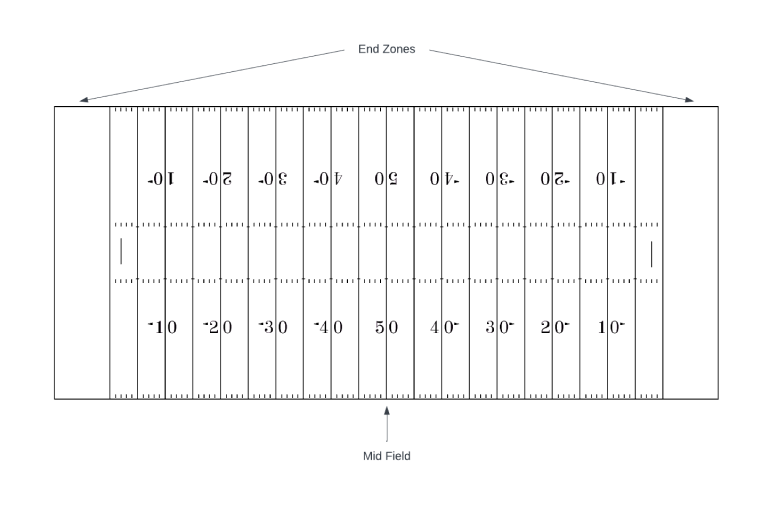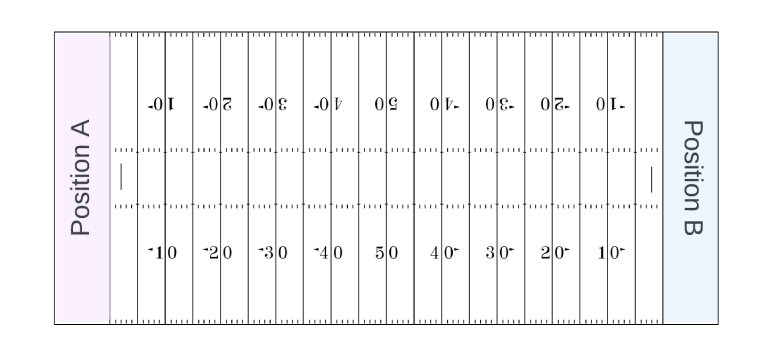
An American football field is a rectangular playing surface 100 yards long and 53.3 yards wide, with marked lines every 10 yards. At each end, there are end zones extending 10 yards past the goal lines, making the total length of the field 120 yards. The field also features a 50-yard line at the center, dividing it into two halves, and hash marks running parallel to the sidelines, which are used to align plays. Goalposts are situated at the back of each end zone for scoring field goals and extra points.
Understanding Distance
The idea of distance in the context of persuasion is about recognizing where individuals stand on a particular issue and how far they are from other potential positions.

The deeper someone is into a particular position, the harder it is to move them away from that stance. The football field analogy helps to visualize this distance and the challenges involved in shifting people’s viewpoints.
The Football Field Analogy
Imagine a football field divided into 100 yards with the 50-yard line marking the midfield. There are markers every 10 yards indicating the distance from each end zone. Let’s say Position A is one end zone and Position B is the other. These positions represent two extreme viewpoints on an issue. For instance, in the healthcare debate, one extreme (Position A) might support completely centralized public healthcare, while the other (Position B) favors the current insurance-based system.

Here’s how we can categorize people based on their positions in the field:
Strong As and Strong Bs
Strong As: These individuals are between 0 to 20 yards from Position A. They are deeply entrenched in their views and strongly support Position A. Their zone of acceptance is within the first 20 yards, and they reject anything beyond this range.
Strong Bs: Similarly, these individuals are between 0 to 20 yards from Position B. They are staunch supporters of Position B and reject anything beyond the first 20 yards.
Strong As and Strong Bs are the most entrenched groups. Their zones of acceptance are narrow, and their regions of rejection are wide. This means they are highly resistant to change and unlikely to consider viewpoints from the opposite end of the field.
Moderate As and Moderate Bs
Moderate As: These people are between 20 to 40 yards from Position A. They are more open to different ideas compared to Strong As. Their zone of acceptance extends up to 40 yards, but they start rejecting ideas beyond that point.
Moderate Bs: These individuals are between 20 to 40 yards from Position B. Like Moderate As, they are relatively open to new ideas and have a zone of acceptance up to 40 yards from Position B.
Moderate As and Moderate Bs are more flexible than their strong counterparts. They have broader zones of acceptance and narrower regions of rejection. This means they are somewhat open to considering opposing viewpoints, though they still have a clear preference for their side of the field.
On the Fencers
Individuals in this category are situated between 40 yards from Position A to 40 yards from Position B. They are in the middle and can be swayed in either direction, much like swing voters in an election. Their central position on the field and wider zone of acceptance makes them more susceptible to influence from either side.
“On the Fencers” are the most crucial group when it comes to persuasion. Their zones of acceptance are the widest, making them the easiest to sway towards either Position A or Position B. Because they are not deeply entrenched in either extreme, they are open to hearing arguments from both sides and can be influenced more readily than those closer to the end zones.
Zones of Acceptance and Rejection
Understanding these zones is key to effective persuasion. The zones of acceptance represent the range within which individuals are open to considering new ideas. The zones of rejection, on the other hand, represent the range beyond which individuals dismiss new ideas outright.
For example, Strong As have a zone of acceptance from 0 to 20 yards and a zone of rejection from 20 to 100 yards. This means they will only consider ideas that align closely with Position A and will reject anything that seems too far from their current stance. Moderate As, however, have a broader zone of acceptance from 0 to 40 yards, indicating they are open to a wider range of ideas but still have a significant zone of rejection from 40 to 100 yards.

Practical Application of the Football Field Analogy
To make this concept more concrete, let’s apply it to a real-world issue. Consider a company that is trying to implement a new performance evaluation system. Employees might have various positions on this issue:
Strong As: Employees who strongly support the current system and see no need for change. They are entrenched in their views and reject any proposals for a new system.

Moderate As: Employees who generally support the current system but are open to improvements. They might accept a new system if it addresses specific issues they care about.

On the Fencers: Employees who see both benefits and drawbacks in the current system and are open to considering a new one. They can be swayed by strong arguments from either side.

Moderate Bs: Employees who are somewhat dissatisfied with the current system and are inclined towards adopting a new one. They need convincing that the new system will be better.

Strong Bs: Employees who are highly dissatisfied with the current system and strongly advocate for a new one. They reject any defense of the current system.

The football field analogy provides a clear, visual way to understand the concept of distance in persuasion. By recognizing where individuals stand on an issue and how far they are from other potential positions, leaders and change agents can develop more effective strategies for influencing opinions and driving change. Understanding the zones of acceptance and rejection, and tailoring communication strategies accordingly, can significantly enhance the likelihood of successfully shifting perspectives and achieving desired outcomes.
To learn more about the role of OKRs in change management
Understanding Confirmation Bias
**Confirmation bias** is the tendency for individuals to favor information that confirms their pre-existing beliefs or values while dismissing or ignoring information that challenges them. This cognitive bias leads people to seek out, interpret, and remember information in a way that reinforces their current beliefs, creating an echo chamber that validates their views and resists change.
People’s positions on the football field determine their zones of acceptance and regions of rejection, shaping how they process new information.
Acceptance of Confirming Information
Individuals are more likely to accept and value information that falls within their zone of acceptance. This information aligns with their pre-existing beliefs and reinforces their current position. For instance, a Strong supporter of public healthcare will readily accept studies, news articles, or expert opinions that advocate for a centralized healthcare system. This information confirms what they already believe, providing validation and comfort.
Rejection of Contradictory Information
Conversely, individuals are likely to reject information that falls within their region of rejection. This information contradicts their beliefs and challenges their position, creating cognitive dissonance. Using the same example, a Strong A individual would dismiss arguments or data favoring an insurance-based healthcare system. They might question the credibility of the sources, find flaws in the arguments, or ignore the information altogether.
Implications of Confirmation Bias
Confirmation bias has significant implications for how people maintain and reinforce their positions on various issues:
Reinforcing Beliefs: By continually accepting information that aligns with their beliefs and rejecting contrary information, individuals reinforce their existing views. This reinforcement makes it increasingly difficult to shift their positions, entrenching them further into their current stance.
Creating Echo Chambers: Confirmation bias leads to the creation of echo chambers, where individuals surround themselves with like-minded people and information sources that echo their beliefs. This environment further strengthens their positions and isolates them from diverse perspectives.
Resisting Change: When new ideas or policies are introduced, individuals influenced by confirmation bias are more resistant to change. They are less likely to consider alternative viewpoints or adapt to new information, as their cognitive processes favor maintaining the status quo.
Confirmation bias is a powerful force that influences how individuals process information based on their positions on the football field analogy. By understanding the zone of acceptance and region of rejection, we can see how people tend to accept information that confirms their beliefs and reject information that challenges them. This bias reinforces existing views, creates echo chambers, and hinders the acceptance of new ideas, making it a critical factor to consider in change management and persuasion strategies.
Ready to start your change management journey?
Related Articles
-
“Burn the Ships” Strategy for Effective Change Management in Business
In the realm of change management, the "burn the ships" strategy stands out as a compelling metaphor for commitment and... Read more
-
Costs of Inaction in Business
Documenting the cost of inaction in a business change management exercise can be categorized into several key areas. Each category... Read more
-
What are the Drivers for Change?
As an organization, there are times when you feel comfortable with your current position and other times when you feel... Read more
-
4 Real-World Examples of Change Strategy
What do all successful companies and organizations have in common? The ability to develop and pivot their strategies for significant... Read more
